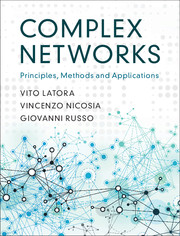Book contents
- Frontmatter
- Dedication
- Contents
- Preface
- Introduction
- Epigraph
- 1 Graphs and Graph Theory
- 2 Centrality Measures
- 3 Random Graphs
- 4 Small-World Networks
- 5 Generalised Random Graphs
- 6 Models of Growing Graphs
- 7 Degree Correlations
- 8 Cycles and Motifs
- 9 Community Structure
- 10 Weighted Networks
- Appendices
- References
- Author Index
- Index
4 - Small-World Networks
Published online by Cambridge University Press: 11 October 2017
- Frontmatter
- Dedication
- Contents
- Preface
- Introduction
- Epigraph
- 1 Graphs and Graph Theory
- 2 Centrality Measures
- 3 Random Graphs
- 4 Small-World Networks
- 5 Generalised Random Graphs
- 6 Models of Growing Graphs
- 7 Degree Correlations
- 8 Cycles and Motifs
- 9 Community Structure
- 10 Weighted Networks
- Appendices
- References
- Author Index
- Index
Summary
“It's a small world!” This is the typical expression we use many times in our lives when we discover, for example, that we unexpectedly share a common acquaintance with a stranger we've just met far from home. In this chapter, we show that this happens because social networks have a rather small characteristic path length, comparable with that of random graphs with the same number of nodes and links. In addition to this, social networks also have a large clustering coefficient, i.e. they contain a large number of triangles. As an example of a social network, we will experiment on the collaboration graph of movie actors introduced in Chapter 2. We will show that the small-world behaviour also appears in biological systems. For this reason, we will be looking into the neural network of C. elegans, the only nervous system that has been completely mapped to date at the level of neurons and synapses. We will then move our focus to the modelling, by introducing and studying both numerically and, when possible, analytically, the small-world model originally proposed in 1998 by Watts and Strogatz to construct graphs having both the small-world property and also a high clustering coefficient. This model and the various modified versions of it that have been proposed over the years, are all based on the addition of a few long-range connections to a regular lattice and provide a good intuition about the small-world effect in real systems. In the last section we will try to understand how the individuals of a social network actually discover short paths, even if they just have local knowledge of the network.
Six Degrees of Separation
Fred Jones of Peoria, sitting in a sidewalk cafe in Tunis, and needing a light for his cigarette, asks the man at the next table for a match. They fall into conversation; the stranger is an Englishman who, it turns out, spent several months in Detroit studying the operation of an interchangeable-bottlecap factory. “I know it's a foolish question,” says Jones, “but did you ever by any chance run into a fellow named Ben Arkadian? He's an old friend of mine, manages a chain of supermarket in Detroit… Arkadian, Arkadian,” the Englishman mutters.
- Type
- Chapter
- Information
- Complex NetworksPrinciples, Methods and Applications, pp. 107 - 150Publisher: Cambridge University PressPrint publication year: 2017



